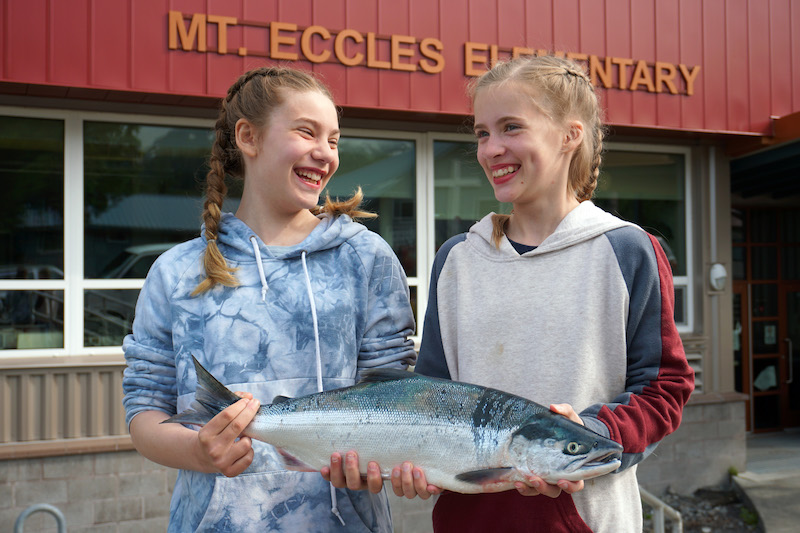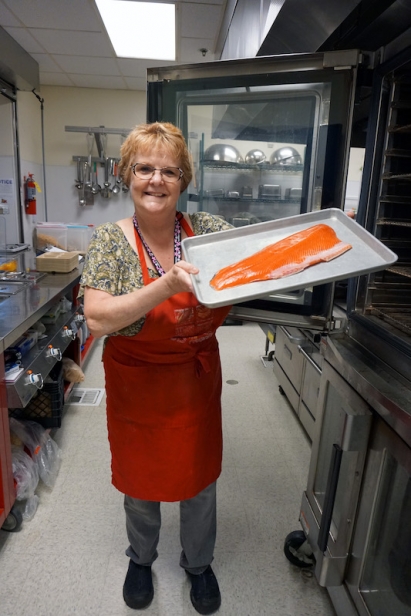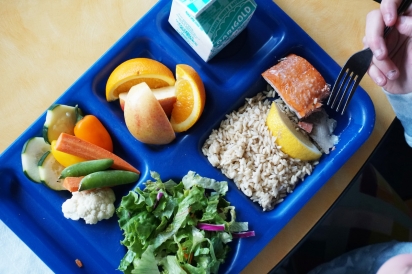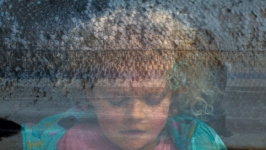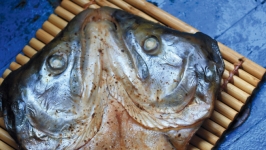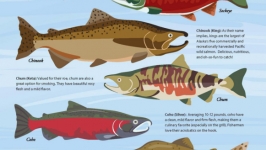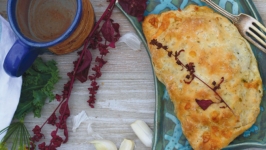Eat Smart - Alaska's Fish to Schools Program
Around the state, Alaskan kids are headed back to school with hungry minds. As summer’s long sun-soaked days come to an end, students in many coastal communities will be able to enjoy bites of summer abundance at school throughout the year. All along the expansive Alaska coastline, commercial fishermen provide school cafeterias with some of the best food in the world: wild Alaska seafood.
The Fish to School program is more than just a lunch offering. It is the result of collaboration between school districts, seafood industry, educational non-profits, and commercial fishermen. Fishermen donate salmon, halibut, and rockfish to school lunch programs either directly or through a local seafood processing facility. The addition of wild, local fish to public school menus is a significant step towards promoting healthy diets of school children, not all of whom have access to fish to at home.
In Cordova, the program is coordinated by the Copper River Watershed Project (CRWP) and Cordova District Fishermen United (CDFU). These two nonprofits have collaborated since 2012 to provide local kids with some of the world’s most nutritious protein. This past summer, 600 sockeye from Prince William Sound were donated to the local Fish to School program. All along the line, from net to plate, many people lend a hand to make sure that this important renewable resource can make its way to the lunch plates of growing kids.
“Tender boats announce they are accepting donations, and during the next commercial fishing opener fishermen set aside a bit of their harvest,” CDFU Program Coordinator Jocelyn Layte explains. “Time and labor is also donated to process it. Giving back is important to our fishing community, so as an organization we’re proud to help make that happen.”
It’s no secret that Alaskans are generous with their neighbors. Even in lean years the donation of fish to schools does not falter. Like many commercial fishermen who donate to the program, Shawn Gilman believes that the job of a fisherman is to make sure a part of the harvest is always shared. “Everyone benefits in times of abundance and, as Alaskans, we band together in times of shortage,” he says of the wild salmon that he harvests every summer.
Sharing wild fish is a source of pride in these coastal communities. Giving to Dillingham’s Salmon to Schools program has even become a good-natured contest between individual fishermen. During deliveries to Peter Pan Seafoods, donation poundage amounts from each fisherman are announced via VHF radio, which encourages friendly competition and also serves as a public thank you. This spirit of pride in giving back is evident as Dillingham continues to have the most robust fish to school program in the state, with commercial fishermen contributing about 8,000 pounds of sockeye salmon to the local school district every year.
Kids aren’t only eating Alaska’s fish, they are learning about them as well. Most of the programs around the state incorporate an educational element, helping connect school children not only to their fishing community, but to the natural world and local food systems around them. Sitka Conservation Society pioneered a classroom curriculum called Stream to Plate that serves as an educational component to the bimonthly lunches. Stream to Plate teaches students about the
life cycle of wild salmon, how they are a keystone species of the ecosystem, and about their connections to both forest and people. The curriculum guide, which is free to download for interested teachers and schools, stresses the importance of sustainability and food justice.
It covers the entire life journey of a wild salmon through seven different lessons ranging from the natural history of salmon in their natal streams all the way to a hands-on cooking class. Since many of these communities’ economies are fueled by the commercial fishing industry, wild salmon are a tangible example of local food systems and natural resources being used in a responsible way.
One of the goals that all of the fish to school programs have in common is the importance placed on locally sourced food and knowledge of how the food was produced.
In Sitka and Cordova, commercial fishermen and salmon biologists are invited to schools to have lunch with kids on days when fish is served. Kate Morse of the Copper River Watershed Project explains, “This part of the program brings community members representing a wide range of jobs tied to the commercial fishery into the school to meet with students, share a little about their job and how it is tied to salmon, and then everyone enjoys a salmon lunch in the cafeteria.”
Students get to ask questions about management, sustainability practices, and harvest methods. Talking with these visitors, who volunteer their time, encourages students to get to know some of the people who helped get the food onto their plate. “It’s important for people to know where their food comes from and it’s great if we can start that conversation and understanding at an early age,” Ezekiel Brown said of the school visits.
Brown is a commercial fisherman in Prince William Sound and grew up in Cordova. He now serves on the board of directors for CDFU and believes it’s one of the most valuable programs the organization helps facilitate. “It’s awesome to see commercial fishermen and industry investing in Alaska’s kids.” While the fish to school approach is fairly new within the state, it has become very popular in a short amount of time and has overcome obstacles of scaling, costs, and fluctuating supply through creative partnerships across multiple sectors.
While students receive a healthy meal and hands-on education from these partnerships, the rest of the state benefits, too. Multiple partners continue to come together over shared values for what matters most — giving back to our communities. After all, if it takes a village to raise a child, in Alaska it takes a fishing fleet to feed them.
Interested in introducing a fish to school program in your community?
Contact your local school district Student Nutrition Director.


